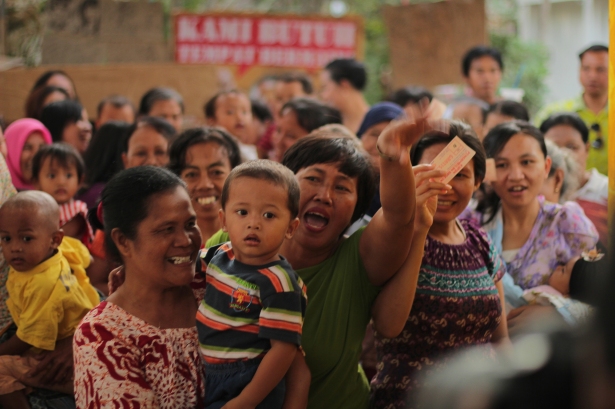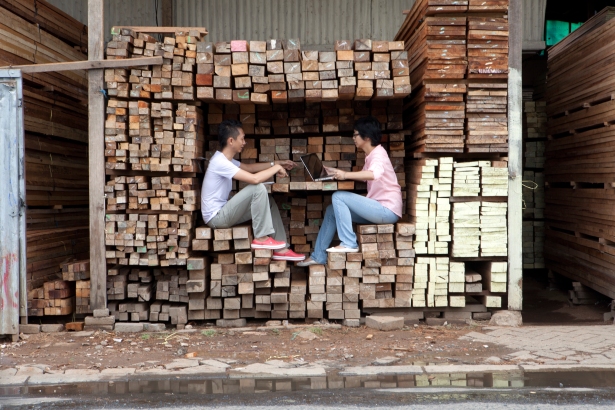This post comes from the Artists and Climate Change Blog
20th of January 2017. A friend from Indonesia calls me. Not for anything in specific, just a bit of friend-to-friend chitchat. I can’t help to start a rant about something that starts with a T and ends with rump. Arief interrupts me: ‘Don’t worry sis’, he says. ‘The world has new countries.’ Arief, I have to explain, runs Jatiwangi Art Factory, a non-profit space in the region of Jatiwangi, and manages to mobilise thousands of people in the wider (rural) area to organize all types of cultural events; from performances to discussions and from exhibitions to radio broadcasts. This community is active, engaged and inclusive. They share responsibilities and resources. Still it takes me a few seconds before the penny drops: Arief is telling me the future is not America, it’s not even China, it’s Indonesia. And the reason is that Indonesia is the country of creativity and the country of the commons.

Not for Sale, picture by Jacob Gatot Surarjo
You must have come across this word recently; commons. Whether it was in an art, environmental, social, or policy context, the term ‘commons’ seems a good candidate to replace 2016’s ‘Post-truth’ and is certainly a more reassuring and constructive buzzword. If you’re not familiar with it yet, my personal, non-academic way of explaining the concept of the commons is as a form of sharing of resources by a community without private or governmental intervention. This could concern inherited commons (for instance rivers, forests, air), immaterial commons (for instance intellectual, cultural) or material commons (for instance machinery). It concerns communal resources that are (or rather could be) managed collectively without identified ownership but with shared responsibility. Though the concept of the commons often remains in the topic of social processes, more and more artists, city planners, environmentalists, philosophers, designers and architects around the world are recognising ‘commoning’ as an interesting way of working and as alternative to our broken capitalist and neoliberal systems – keeping commodification, commercialisation and privatisation at arm’s length. Indonesian urbanist Marco Kusumawijaya explains: ‘communities can play an important role in moving towards a different paradigm that is not dominated by capitalism and neoliberal governments. Rather, communities[1] can be the stewards of land and resources as well as being an essential place where relationships, alternatives, substitutes and critiques are constantly in the making.’

Elia Nurvista. Performance. Hunger Inc. Courtesy of Jogja Biennale
Indonesia has a long history of what we might now call ‘commoning’ but what is locally known as gotong royong[2] or bersama sama.[3] Traditionally both social and environmental stewardship have been at the heart of Indonesian kampung[4] life and in Indonesia artists have a key role in keeping this spirit alive. Artist Gustaff Harriman Iskandar explains that artists traditionally have a special status and social function in Indonesian society. ‘The artist often has an important position in the community (sometimes as spiritual leader, or politician) and is expected to make a contribution to society. They are not seen in the individual domain but rather seen in a social context.’

Irwan Ahmett and Tita Salina. ‘Trash Ball’.
Beside their sometimes ‘special status’ artists in Indonesia often work in collectives. Art collectives across Indonesia, and particularly in Yogyakarta, are practising this way of working in which they share knowledge, skills, responsibility and resources. Because the government often lacks in providing resources for artists, the artists started to organise themselves. ‘The sheer size of the country [1] makes that things only work on a small scale’, artist Andreas Siagian from Yogyakarta based art/science collective Lifepatch explains. In a country that is so big and diverse, things function better in smaller systems and structures that allow for flexibility, fluidity and self-organising. Lifepatch enjoys the process of collaborating and call this approach DIWO: ‘Not just do it yourself (DIY) but to do it with others (DIWO).
Across Indonesia art collectives are leading the charge in creating alternative ways of dealing with our resources, alternative currencies, exchanging skills, repairing, that have created a strong DIY culture and arts infrastructure, are innovating, experimenting and having fun. The collective is a good alternative to what artist Ade Darmawan from Ruangrupa calls ‘the big structures’. ‘Big structures have more difficulties to be relevant. They are always slow. You need to have real conversation with society and they miss a radar or mapping system. That’s lost. It’s hard for an institution to be localised. My experience with Ruangrupa is not bringing the community to an institution but the other way around.’
At Arsitek Komunitas, a community architecture initiative in Yogyakarta, each project starts with advice from the community. ‘The community doesn’t want to be an object in the collaboration’, says Amalia Nur Indah Sari from Arsitek Komunitas. ‘Our principle is: believe the people, they are the solution. You need to trust the community and the community needs to trust you.’

Irwan Ahmett and Tita Salina. ‘Public Furniture’. Jakarta, 2010.
In addition to Indonesia’s creativity, solidarity and resourcefulness, there is a vast amount of (localised) knowledge of the natural world, whether it’s the indigenous communities in Riau, farmers on the rice fields of Bali practising subak[2] , or the Tukang[3] in Jakarta, the amount of knowledge and creativity this country holds is unseen of. All together it forms a strong set-up for a sustainable society. There is so much to learn from this society that has been through wars and genocide, which is at the forefront of climate change, centre of environmental degradation and one of the biggest carbon emitters in the world.This is our chance to widen our thought horizons: there are alternatives on offer.
[1] Indonesia is not only the world’s fourth most populous country in the world with its 257,563,815 inhabitants: http://data.worldbank.org/country/indonesia, based on data from 2015
[2] A sustainable form of water management developed in the 9th century that is based on sharing.
[3] Repairmen
[1] Kusumawijaya explains community as ‘a group of people where its members live together in a territory, and share some commons in concrete way, with bounds and consequences immediately felt when something goes wrong.’
[2] Refers to a collaborative approach and a way of working for a higher communal goal
[3]Â A Malay word that translates as togetherness.
[4]Â Village or community
This research was commissioned by the Asia-Europe Foundation and the full research publication will be freely available on Culture 360 from April 2017.![]()
Artists and Climate Change is a blog that tracks artistic responses from all disciplines to the problem of climate change. It is both a study about what is being done, and a resource for anyone interested in the subject. Art has the power to reframe the conversation about our environmental crisis so it is inclusive, constructive, and conducive to action. Art can, and should, shape our values and behavior so we are better equipped to face the formidable challenge in front of us.


